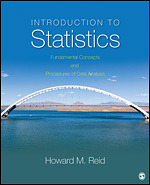Introduction to Statistics
Fundamental Concepts and Procedures of Data Analysis
- Howard M. Reid - SUNY Buffalo State, USA
Using a truly accessible and reader-friendly approach, this comprehensive introduction to statistics redefines the way statistics can be taught and learned. Unlike other books that merely focus on procedures, Reid’s approach balances development of critical thinking skills with application of those skills to contemporary statistical analysis. He goes beyond simply presenting techniques by focusing on the key concepts readers need to master in order to ensure their long-term success. Indeed, this exciting new book offers the perfect foundation upon which readers can build as their studies and careers progress to more advanced forms of statistics.
Keeping computational challenges to a minimum, Reid shows readers not only how to conduct a variety of commonly used statistical procedures, but also when each procedure should be utilized and how they are related. Following a review of descriptive statistics, he begins his discussion of inferential statistics with a two-chapter examination of the Chi Square test to introduce students to hypothesis testing, the importance of determining effect size, and the need for post hoc tests. When more complex procedures related to interval/ratio data are covered, students already have a solid understanding of the foundational concepts involved. Exploring challenging topics in an engaging and easy-to-follow manner, Reid builds concepts logically and supports learning through robust pedagogical tools, the use of SPSS, numerous examples, historical quotations, insightful questions, and helpful progress checks.
“The text is VERY well written…I like the logical flow of the text the BEST. I also like the outlines, tables, explanations of symbols inserted within the text. I find them very appropriate in the timing of presentation and thus helpful to continue reading the sample chapter.”
—May Takeuchi, University of North Alabama
“It’s easy to read, well explained, student-friendly and a little fun. The author is very knowledgeable about statistical analyses and history. SPSS outputs are a good touch. I also love the mathematics in the introduction because I have to go over this very same information at the beginning of each semester and other texts don’t typically provide it the way it is done here (these are all the mathematical functions that the students need to know to succeed in a statistics class).”
— Cornelia Brooks, Bowie State University
“I really like the multiple-choice quiz questions at the end of the chapters. Students typically struggle with multiple-choice questions at the beginning of this course. They don’t really understand why there are such questions in a “math” class. Having these quizzes in the textbook would really help them work through that.”
—Christy Miller Cowan, Lincoln Memorial University
“It is very readable with clear explanations and examples.”
—Michael A. Bock, American International College
“I like the focus on definitional formulas rather than computational formulas. I think the description of how to use SPSS is extremely clear.”
—Kristi Lemm, Western Washington University
“After reviewing the full text I believe that the presentation, organization, and writing style of this book are a breakthrough in terms of the statistics books available for courses such as mine.”
—Thomas Uttaro, College of Staten Island, City University of New York
“The organization around data types and links across chapters are the key advantages to this text. Also the end matter of each chapter is very good. The succinct summary of the procedure, when it is used, and its underlying assumptions are excellent. Inclusion of the SPSS exercises is also a major advantage.”
—Joseph G. Johnson, Miami University
“The text is accessible; it is engaging. I like the organization based on levels of measurement, and the “math instruction” in the Introduction. My students would appreciate the variety of examples. I very much like the explanation of “why ANOVA” linked to Table 10.2 with the presentation of error rates. I think that keeping track of the assumptions at the end of each chapter is a wonderful idea/check, and I like the manner in which the author includes material on “regression to the mean,” which is often buried in a methods text without meaningful references.”
—Marilyn Dantico, Arizona State University
“…The examples provided are good for helping students understand the math behind and meaning of the calculated statistics. I also think that the SPSS walkthrough would be beneficial to those courses where SPSS is utilized. In addition, I like the chapter titles that re-emphasize what sort of data is being analyzed for the various statistics that are calculated (e.g., Chapter 9 spells out that Interval and Ratio data are utilized in one sample Z and T tests).
—Johnathan D. Forbey, Ball State University
“This text helps students understand how each aspect of psychology is one piece of a complex puzzle which together provides a complete picture of the study of psychology as a whole.”
—Nanette Silverman, Dowling College


